Link #1
Anton’s “What’s in Your Bag?”
https://blogs.ubc.ca/communicationexplorationadidak/2021/09/13/whats-in-my-bag/
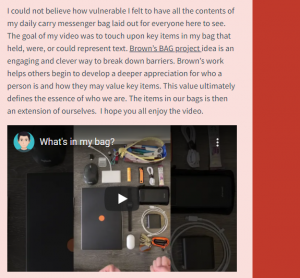
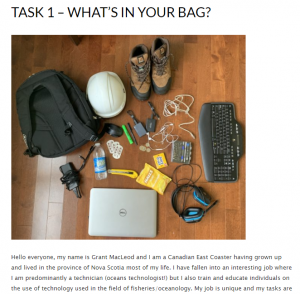
For my first linking assignment, I decided to link with Anton’s What’s in the bag? Although he chose to use video to display what was in his bag and I just took a photo, I thought his contents and reflection were similar to my own. Anton does a great job presenting the contents of his bag and explaining why each of the items he carries has personal value.
Though we have different careers (Anton in the classroom, and me in the field), it seems like we both dabble with a few electronics and robotics work. This is reflected in our reflections and some of the items that we carried in our bags such as laptops, hard drives, chargers, cables, etc. Both of our bags show that we mainly use digital forms of text for our current jobs. We use our laptops and our mobile phones to connect/communicate with our students (or trainees) and work colleagues.
One thing I noticed that was different, is that the language Anton uses is a bit more informal compared to the more formal language in my written text. For him, I think this is due to the unscripted nature of his presentation, as I assume he just wants to present in a way that is comfortable for his audience. I imagine if I were to create a video for my bag, my language would have been similar to Anton’s other than the pronunciation or words due to different English slangs, him having a west coast slang, and me having an east coast slang.
Another thing that resonated with me was when Anton reflected on the note from a student that he carries with him. Although it couldn’t be seen in my photo, I also carry a note from a former student which I read occasionally if I need a little positivity boost. I’m not sure about Anton, but I could have just kept this note in a digital form on my laptop or mobile phone but because the note is handwritten it feels more genuine and meaningful. For me, my note was written by a non-English native speaker so it feels even more special.
Link #2
Mike’s “Voice to Text”
https://blogs.ubc.ca/etec540f2021/2021/09/26/task-3-voice-to-text/
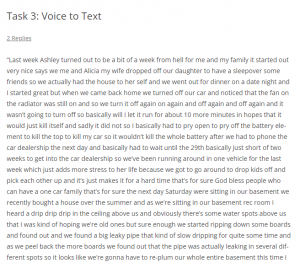
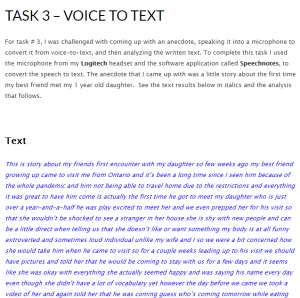
When I read and tried to decipher Mike’s Voice to Text story, I could definitely understand his frustrations with his car and house problems. I too recently purchased a house with my wife and we have had issues with leaking pipes and windows as well so I can appreciate what Mike had to share. Not only did his story resonate with me but through his reflection, it seems like he had similar thoughts that I had when working on this task.
Although we used different voice-to-text apps, Mike with a phone app and me with a web app, we both had similar results. Both stories lacked punctuation like periods, exclamation marks, commas, or quotations which lead to poor sentence structure. This made both of our stories seem like long run-on sentences which makes it difficult to read for the reader because there is no separation of sentences to provide pauses.
Another similarity between our reflections is that there wasn’t too much “wrong” with our stories. We both indicated that most (in not all) of the words that we spoke were included in the translation. Most words were spelled correctly but there were a few incorrect words chosen that made our stories at times a bit difficult to understand. We also thought that if our stories were scripted then they would have been more accurate regarding word choice and spelling but felt perhaps some of the meaning from the oral version would have been left out in the text. However, overall we both felt that our apps did a good job matching the words that we spoke.
One thing that I appreciated from Mike’s reflection was his discussion about indigenous languages and oral storytelling. He made a connection with oral storytelling in his “voice to text” task and the struggles that indigenous communities are facing with language loss. Indigenous knowledge is traditionally shared orally through storytelling from Elders but because of colonialism and imperialism (and the passing of Elders), this knowledge is not getting passed down to the youth. Mike emphasizes that one of the benefits of oral storytelling is that when it is shared with others it doesn’t lose its meaning like writing can. I think this is true, and that even though sharing knowledge orally has some downsides, it still has incredible value and should be protected.
Link #3
Robyn’s Potato Prints
https://blogs.ubc.ca/reoliver/2021/10/02/task-4-potato-prints/

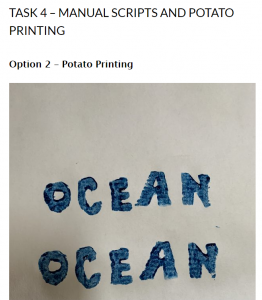
I enjoyed reading about Robyn’s potato print task as unlike me, who has little art experience, she has an art background and teaches art in school. So it was interesting to read the perspective of someone like her. As I read her reflection I wondered what she might have been thinking or experiencing while she worked on this task as someone who has a strong understanding of art. Did she know what to do without reading the instructions? Did she make a plan or just know right away where to start? Did she use her past experiences to complete the task? Did she experience the frustrations that I felt?
When I started this task I read through the instructions at least twice because I wanted to make sure I completed the task correctly. I only had a few potatoes too, so I didn’t have a lot of room to make mistakes. Even though I thought I knew what I was doing, I still managed to make mistakes and had to redo some of my potato stamps and prints. I carved letters backward and stamped them incorrectly. The whole task took me about 30-40 minutes to complete because of the errors that I made. I’m sure this was different from what Robyn experienced because she had done this before and was very familiar with stamping and screen printing. Unlike me, she knew right away that she had to carve some letters backward so that they would print correctly on paper. This task only took her 10 minutes as well so she must have made little to no mistakes at all. I also pre-wrote the letters on my potatoes unlike her so I think we had different experiences with this task.
Although the experiences Robyn and I had during the making of the potato prints were probably different, I think we shared a similar reflection where we appreciate how technology such as the printing press, typewriters, and word processors, have evolved and allowed us to print much easier and quicker than earlier technologies such as these potato prints. Like Robyn said, I wouldn’t want to print a book this way or print this linking assignment using potato prints as it would be an extremely time-consuming and in my case frustrating activity. I think we both appreciate the effort and skill that was needed for primitive or early forms of printing but are glad that we can use the easier and more efficient forms of printing technology that we have today.
Link #4
Melissa’s Emoji Story
https://blogs.ubc.ca/melissaguzzo/2021/10/15/task-6-an-emoji-story/
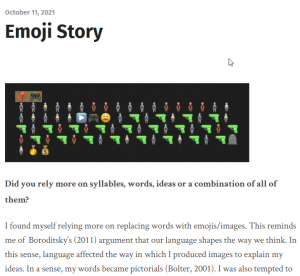
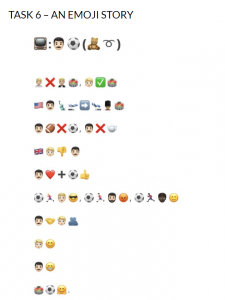
When I first looked at Melissa’s Emoji story, I guessed right away what the title of her show was. Perhaps it was the popularity of the show (seems like everyone is talking about it) but I think it was Melissa’s choice of emojis that made it so intuitive. Similar to my own Emoji story, Melissa chose a popular new show for her assignment. Like me, she started with the title and used a TV emoji followed by a colon to give an indication that she was referencing a television show. She followed that with two emojis that, to me, gave a clear indication of what they stood for. Another similarity between her and my story was that we both chose emojis to represent the words and ideas of our specific shows.
Although the title of her show was easy to guess I found her plot a bit more challenging. Even though I guessed the title and had heard of the show, I hadn’t seen it before, so I had a hard time deciphering this plot. I’m not sure if this was the case for Melissa but when I was trying to select emojis I felt I had a limited selection of emojis to choose from with the application I was using. From what I can tell, she used the same application as me so I am wondering if she felt the same frustration that I felt when writing my plot. There were certain words/ideas I wanted to use but there were no emojis that fit. In her reflection, she mentioned that each emoji she used had meanings that she thought best describe her plot but I wonder if these were just the best options available to her. This is where I currently see a limiting feature of emojis, which is that unlike words they can’t fully represent every word or idea.
In Melissa’s reflection she asked an interesting question, “is there a universal understanding of what each emoji is for?” It made me wonder if emojis were a universal language. To a certain degree, I would say yes. For example, a Canadian would have the same understanding of a smiley face emoji as people from other parts of the world. Same with the red X emoji, most people in the world would understand what this emoji means. However, there are many emojis that mean different things to people depending on which country or culture they are part of. For example, the thumbs-up emoji in western culture means “a sign of approval” but in the middle east, it is offensive. The angel emoji in the US means “doing a good deed” but in China, it means “death”. If emojis were universal or a universal language then everyone would understand what they mean. But that is clearly not the case as there are many emojis that have different meanings. So perhaps emojis are not a language or fully universal but can be looked at as being more like communication enhancers that can do a better job of adding emotion to a conversation than just words.
Link #5
Megan’s Mode Bending
https://blogs.ubc.ca/mravenhill/2021/10/24/task-7-mode-bending/
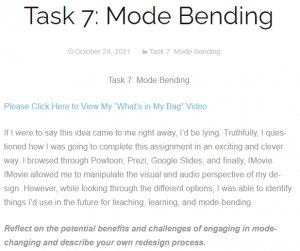
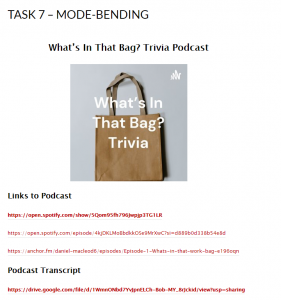
Megan and I both chose different modes for our “What’s in your bag” adaptation task. Megan chose to make a movie trailer and I created a podcast. From what I can tell from her reflection, she wanted to make something that was fun and entertaining for our classmates and this was part of my goal as well. Megan referenced the New London Group (1996) reading in her reflection where they suggest that people will have a greater chance of learning if they are motivated and intrigued. This is what I was trying to do with my trivia game podcast, to make it more intriguing and motivating for my audience and this is what Megan did too.
Changing the semiotic mode of an assignment or task not only allows for this motivation but also provides another option for those who have greater strengths in other forms of learning. For example, in my first “What’s in your bag?” task I just provided a photo and text, for someone who learns better through spoken language or someone who has limited vision, this would have been a difficult task to understand. However, this person would probably do much better with my podcast version of the “What’s in your bag?” task. Megan reflects on this too when she mentioned how the BC public school curriculum focuses greatly on providing different modes of learning such as linguistic, auditory, visual, spatial, and textual.
Another benefit of mode bending, something that I found especially true, is that it allows individuals to be more creative which in turn enhances their learning and pedagogy. Megan referenced the Cope and Kalantzis (2009) reading where they discuss multimodal learning and how individuals can create more meaning and learning by engaging in multiple forms of learning as opposed to one singular form. For myself, I broke out of my comfort zone having never created a podcast before, and by doing this I learned a whole new way to communicate and share my knowledge. I think if I just continued to stick with what I was comfortable with I wouldn’t have grown or learned anything.
Link #6
Lynda’s Attention Economy
https://blogs.ubc.ca/lyndayearwood/task-10/

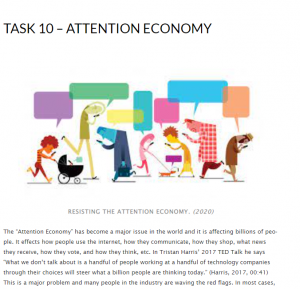
Reading Lynda’s reflection on this task made me think about my own experience with ‘User Inyerface’. I too thought that this website was a paradigm shift from mainstream web user interfaces and that many of the design aspects for the form were difficult to get through. Most aspects of the website seemed to be either opposite of current web practices or simply just different. For example, Lynda and both mentioned how the website used different color schemes than what the mainstream users are familiar with. The big green button the said “No” is clearly not what we are used to as we typically associate green with ‘Go’ or in this case ‘Yes’.
An interesting point she mentioned was that even with the way this website was designed, how a user interacts or makes their choices could become a learned behaviour. And this is what many websites can do, is prey upon our “Learned Behaviours”. Since most people are used to filling out forms and using web interfaces we don’t always take the time to make sure we are doing is what we actually want. Dark patterns are sometimes difficult to notice.
Lynda’s mention of the famous Cambridge University experiment which highlights how the human brain recognizes patterns when we are interpreting visuals was much appreciated. I actually have never heard of this experiment so I found it very interesting and relatable to this task. Like many people, I am sure, I was able to fully read this paragraph, “Aoccdrnig to a rseearch at Cmabridge Uinervtisy, it deos not mttaer in what oredr the ltteers in a wrod are, the olny iprmoatnt tihng is taht the frist and lsat ltteer be in the rghit pclae.” (Raynar et al., 2006, p. 192), even though the letters were not in the correct order.
Regarding ‘User Inyerface’, as Lynda points out, once it is figured out that many of the clicks and checkboxes were opposite of what is normal, it is much easier to get through this game. I felt this too, after an initial struggle with the game. As web user interfaces adapt over time we will have to learn new behaviours to interact with the new features that are developed. This will take time but usually, there is a gradual shift unlike what was presented in this task.
Reference
Rayner, K., White, S. J., Johnson, R. L., & Liversedge, S. P. (2006). Raeding wrods with jubmled lettres: There is a cost. Psychological Science, 17(3), 192-193. https://doi.org/10.1111/j.1467-9280.2006.01684.x